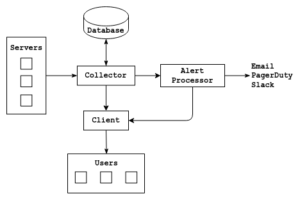There are plenty of paid and free system monitoring tools available in the market. But sometimes building something on your own is fun and a learning experience. One of our DevOps engineers at CMS – Dhamith did exactly that and built SyMon.
SyMon is a simple Linux system monitoring tool written in Go. It is primarily for monitoring smaller servers, home PCs, and devices like Raspberry Pi, but later extended to support full-fledged system-level monitoring on Linux systems. SyMon also supports custom time-series data collection. It could be used to collect sensor or application output/performance data.
Currently, it gathers following metrics under the monitoring interval given in the configuration file.
- System Info
- CPU Info
- Memory/SWAP info
- CPU/Memory usage graphs for past hour (default) or custom time range
- Disk usage and usage graphs
- Network usage info and graphs
- Whether a service is running or not
- 10 processes running on the system sorted by CPU or Memory usage
- Custom metrics (time series data) collection and graphs
- Showing metrics graphs in custom time/date ranges
- Point-in-time data loading of processes for CPU/Memory usage
- Alert setup for CPU/Memory/SWAP/Disk/Service
- Push alerts to user via Email, PagerDuty, or Slack
- Custom data retention period

Get SyMon
GitHub: https://github.com/dhamith93/SyMon
Download: https://github.com/dhamith93/SyMon/releases
Components

Symon has four major components users can use to collect metrics and process alerts.
Agent
Agent has to be installed in the system you want to monitor. Once it is installed and configured, it will collect and send out metrics to the Collector in a given collection interval. It also can be used to send out custom metrics to the Collector. Custom metrics can be used to collect application, process data, or sensor data periodically through a cron job or script/application.
Collector
The Collector is a required component of SyMon. Collector requires MariaDB version >= 10.5 to store the data which is sent to it by collectors. Once set up, it can collect monitor data from multiple servers. It also checks alerts given by the alert config file. If an alert is raised, status changed, or resolved it will push them to the Alert processor. Collected monitor data will be purged every 60 days by default. However, it can be configured through the config file.
Alert Processor
Alert processor is an optional component of SyMon. You can skip the Alert processor if you wish only to collect and visualize metrics and custom data. However, if you wish to set up alerts, you can use the Alert processor to push out incoming alerts or alert status changes to Email, PagerDuty, and Slack. The UI element, or the Client component of SyMon also uses the Alert processor to get raised alerts.

Client
Client component is the user interface component of SyMon which is accessible from browsers. It requests data from the Collector and displays data as graphs or tables. It also can be used to see which are the active servers and which are not active or have trouble connecting to the Collector.
Client component can show all collected data as tables or graphs, which includes the custom metrics pushed by the agents. Currently this does not require any user authentication, but authentication and HTTPS can be set up using NGINX or Apache. Authentication is recommended if this is used in public networks.
How to use
Installing the Collector
First step is to install MariaDB (version >= 10.15) and create a database. Once it is set up, config.json file should be filled with the required configurations. Which includes database name, user, and host information. .env file should be used to set the database password. alerts.json should be used to set up alerting rules. Setting up alert rules is optional and can be skipped if alerting is not used.
Once everything is set up, you have to initialize the collector by running the below command. It will create the database tables and generate the key file.
./collector_linux_x86_64 --init --config=config.json
Once initialized, you can run the collector by running below command. It is best to set this up as a service.
./collector_linux_x86_64 --config=config.json --alerts=alerts.json
Installing the Agent
You should first install Collector, initialize, and copy over the key file to the server to install the agent.
Once the key file is in the same directory as the executable and the config.json file is set up. You can register the agent to the Collector by running the below command.
./agent_linux_x86_64 -init
Once initialized, run the agent (preferably as a service) to enable the metrics collection.
Custom metrics collection
Custom time series data can be added using the agent as below. Current server time will be taken as the time. Running the below command with the parameters will send out the data to the Collector. This can be done manually, using a cron job, or through an application.
./agent_linux_x86_64 -custom -name=test -unit=byte -value=1.0
./agent_linux_x86_64 -custom -name='active-http-requests' -unit='requests' -value=$(netstat | grep -c https)

Running the Alert Processor
This is an optional part of SyMon. It is only needed if you need to process alerts and push them out to Email, PagerDuty, and Slack.
Fill the config.json and .env file with configurations and API credentials for PagerDuty/Slack and run the Alert processor.
./alertprocessor_linux_x86_64
Running the Client
To run the Client, fill the config.json and start the Client with the below command. You can use NGINX/Apache to set up SSL and user authentication if needed.
./client_linux_x86_64
API
Client also exposes an REST API to retrieve collection data.
- /system
- /memory
- Returns memory info/usage
- /swap
- /disks
- Return disk info/usage per disk
- /network
- Return disk info/usage per interface
- /alerts
- /processes
- Returns list of processes using most CPU/RAM
- /processor-usage-historical
- /memory-historical
- /services
- List of services enabled to monitor in agent’s config.json
- /custom-metric-names
- /custom?custom-metric=name
- Required GET parameters
- serverId= ID of the server
- Optional GET parameters
- from=[unix timestamp]&to=[unix timestamp] values within a time range
- time=[unix timestamp] value(s) at a certain time (depends on availability of data)

Author: Dhamith is a DevOps Engineer at CMS working for a US tech client. You could follow his articles at https://blog.dhamith.me/





